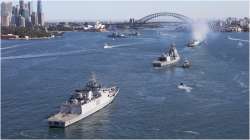Two Indian Navy warships, INS Kolkata and INS Sahyadri, are set to take part in the maritime exercise MALABAR 2023 in Sydney, hosted by the Royal Australian Navy from Friday till August 21. Apart from India, other navies of Quadrilateral Security Dialogue, or Quad such as the US Navy, Japan Maritime Self-Defense Force (JMSDF) will also take part in the exercise.
According to the Ministry of Defence, the Malabar exercise 2023 will take place in two phases. Firstly, the Harbour Phase will include wide-ranging activities such as cross-deck visits, professional exchanges, sports fixtures and many interactions for planning and conducting the next phase. The next Sea Phase involves various complex and high intensity exercoses in all three domains of warfare that will encompass anti-surface, anti-air and anti-submarine exercises, including live weapon firing drills.
The Malabar exercise presents an opportunity for the Indian Navy to enhance and demonstrate interoperability, while gaining from best practices in maritime security operations from its Quad partners. The maritime exercise is part of efforts by the Quad to deepen their partnership for a free, open and resilient Indo-Pacific.
What is the Malabar exercise?
Malabar is a series of complex navy-led exercises between member states of QUAD countries. It started as an annual bilateral naval exercise between India and the United States in 1992. Japan joined the naval exercises in 2015, and Australia became the latest entrant in 2020.
The primary objective of these exercises is the enhance the synergy, interoperability and coordination between the navies of the four countries, reflecting their views on maritime issues and shared commitment to an inclusive Indo-Pacific region and a rules-based international order.
The Indian Navy had hosted the 24th edition of the maritime exercise in 2020 and Japan hosted it last year. This year, Australia will host the Malabar exercise for the first time since it joined the alliance. Two major Australian ships, the HMAS Brisbane and HMAS Choules, are set to take part in the exercise.
A destroyer from the US side and a major surface vessel from Japan will also be seen in this year's exercise. The maritime drill is being held as China is flexing its military muscle across the South China Sea.
About the Quad
The Quadrilateral Security Dialogue, or Quad, is a strategic security partnership between the United States, India, Japan and Australia. It was officially launched by Japan's former Prime Minister Shinzo Abe in 2007. The creation of this military agreement was largely linked to the military and economic power of China, which protested against the Quad and termed it as an 'Asian NATO'.
However, Australia pulled out of the Quad the following year fearing antagonistic relations with Beijing. Although some military exercises were conducted, the partnership largely remained dormant until it was revived in 2017 by leaders including Prime Minister Narendra Modi, former US President Donald Trump, Japan's PM Abe and Australian ex-PM Malcolm Turnbull. The first formal meeting of the Quad leaders took place in 2021.
All sides have expressed that the Quad is not aimed towards any country, yet it is widely considered that the resurrection of the partnership has primarily aimed to counter Beijing's challenges to democracy and its growing aggressiveness in the Indo-Pacific region, particularly its Belt and Road Initiative (BRI) across Asia and the Pacific, that comes with strings attached. The Chinese provocation in Doklam in 2017 is considered one of the major reasons for India's renewed interest in the deal.
In a meeting in May, the Quad leaders expressed concern over the ongoing Russia-Ukraine war and exuded commitment in strengthening commitment in the Indian Ocean Region. They have also announced initiatives in clean energy supply chains, health security partnerhsips, cable connectivity and resilience and open Radio Access Network (RAN) deployments.
About INS Kolkata and INS Sahyadri
INS Sahyadri is the the third ship of the indigenously designed and built Project-17 class multi-role stealth frigates and is presently commanded by Captain Rajan Kapoor, said the Ministry of Defence. On the other hand, INS Kolkata is the first ship of Project-15A class destroyers and is commanded by Captain Sharad Sinsunwal.
Both ships are fitted with state-of-the-art array of weapons and sensors to detect and neutralise threats in surface, air and underwater domains.
ALSO READ | Indian Navy's INS Khanjar rescues 36 fishermen stranded in Bay of Bengal
